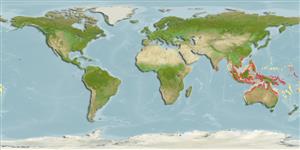Reptilia |
Squamata |
Hydrophiidae
Environment: milieu / climate zone / depth range / distribution range
Ecology
Demersal; depth range 0 - 23 m (Ref. 78387). Tropical; 22°N - 58°S (Ref. 356)
Indo-West Pacific.
Length at first maturity / Size / Weight / Age
Maturity: Lm 47.2, range 39 - 85 cm Max length : 96.0 cm SVL male/unsexed; (Ref. 74665)
Moderately built. Cream to salmon-colored above with irregular blackish cross-bands that taper and terminate on the sides or extend ventrally. Scales in the paler interspaces with dark margins; interspaces contain secondary darker blotches. Ventrals vary from entirely blackish to pale with dark median zone. Head uniform brown or flecked with darker. Head shields enlarged and symmetrical without fragmentation.
Samples taken in deeper waters; suggesting that it does not inhabit clear reef waters (Ref. 2357).
Life cycle and mating behavior
Maturity | Reproduction | Spawning | Eggs | Fecundity | Larvae
Cogger, H.G. 1975 Sea snakes of Australia and New Guinea. In W.A. Dunson (ed.) The biology of sea snakes. Baltimore, University Park Press. Chapter 4:59-139. (Ref. 2357)
IUCN Red List Status
(Ref. 130435: Version 2025-1)
CITES status (Ref. 108899)
Not Evaluated
Not Evaluated
Threat to humans
Human uses
| FishSource |
Tools
More information
Trophic EcologyFood items (preys)
Diet composition
Food consumption
Predators
Life cycleReproductionMaturityFecunditySpawningEggsEgg developmentLarvae PhysiologyOxygen consumption
Human RelatedStamps, coins, misc.
Internet sources
Estimates based on models
Preferred temperature
(Ref.
115969): 25.4 - 29.3, mean 28.7 (based on 2730 cells).
Resilience
High, minimum population doubling time less than 15 months (K=0.57).
Fishing Vulnerability
Moderate vulnerability (45 of 100).
Price category
Unknown.
